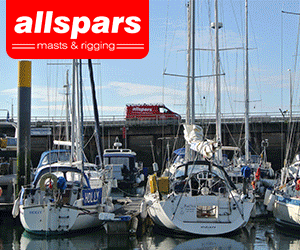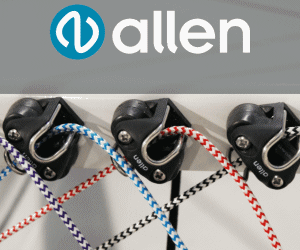Tacking in The Zone |
Post Reply 
|
Page 12> |
| Author | ||||
mopuk2000 
Newbie 
Joined: 26 Jul 06 Location: United Kingdom Online Status: Offline Posts: 22 |
 Post Options Post Options
 Quote Quote  Reply Reply
 Topic: Tacking in The Zone Topic: Tacking in The ZonePosted: 24 May 17 at 12:31pm |
|||
|
I'm not sure what is correct here. I did turns anyway...
Two boats approaching a wing mark on starboard. Boat A is entitled to room from boat B who is pretty much parallel and about a boat length to windward (flying fifteens) - i.e. no offset fore or aft. Due to a huge wind shift (header) about 1 boat length before the mark, both boats are forced to tack. Once Boat B thinks they have gained enough height to round the mark given the new wind direction, he tacks back onto starboard and calls. Boat A tacks onto starboard to avoid the collision but with insufficient room to clear the mark and therefore hits it. Boat A did turns. I can't find anything in rule 18 that explicitly deals with the situation where Both boats tack in the zone. |
||||
 |
||||
JimC 
Really should get out more 

Joined: 17 May 04 Location: United Kingdom Online Status: Offline Posts: 6662 |
 Post Options Post Options
 Quote Quote  Reply Reply
 Posted: 24 May 17 at 1:19pm Posted: 24 May 17 at 1:19pm |
|||
|
I'm not sure it needs to say anything explicit.
Were the boats were overlapped after both had tacked onto port? Think that makes a difference. Edited by JimC - 24 May 17 at 1:21pm |
||||
 |
||||
jeffers 
Really should get out more 

Joined: 29 Mar 04 Location: United Kingdom Online Status: Offline Posts: 3048 |
 Post Options Post Options
 Quote Quote  Reply Reply
 Posted: 24 May 17 at 1:21pm Posted: 24 May 17 at 1:21pm |
|||
|
It would come down to when b tacked as being the RoW boat did they give A sufficient room to keep clear (rule 16.2 I believe RoW boat changing course).
It sounds like there was not a lot of separation to me so B may be on dodgy ground. Knowing the separation between the boats would help and also if they were overlapped once the first tack was completed. I believe it is not a Rule 18 question until after the final tack (in this case) is completed.
|
||||
|
Paul
---------------------- D-Zero GBR 74 |
||||
 |
||||
Brass 
Really should get out more 
Joined: 24 Mar 08 Location: Australia Online Status: Offline Posts: 1151 |
 Post Options Post Options
 Quote Quote  Reply Reply
 Posted: 24 May 17 at 1:59pm Posted: 24 May 17 at 1:59pm |
|||
|
Assuming boats never leave the zone. Assuming also that neither boat alleges that any rule was broken until A finally tacked into the mark (although, as indicated, there are several opportunities for breaches of right of way or room to keep clear rules before then). Once the wind shifts so that both boats must tack to round the mark they are both on a beat to windward (Case 132). When B passes head to wind, boats are on the same tack, at least one of them is in the zone and rule 18 once again applies. In this instance of rule 18, neither was clear ahead or overlapped inside when she reached the zone, so rule 18.2( b ) does not apply, and rule 18.2( a ) does, that is, whichever boat is is overlapped outside (in this case B) is required to give the other mark-room. When B again passes head to wind from port onto starboard, rule 18, once again ceases to apply, because the proper course for A will be to tack (rule 18.1( b )), and while B has not yet reached a close hauled course, and A has not yet passed head to wind, B is required to keep clear of A (rule 13). Once B reaches a close hauled course on starboard, A is required to keep clear of B (rule 10), but B is required, initially, to give A room to keep clear (rule 15). When A passes head to wind from starboard onto port, rule 18.2( a ) once again begins to apply. B was not on starboard since entering the zone, so rule 18.3 does NOT apply. Until A reaches a close hauled course, A is required to keep clear of B (rule 13), but B is required to give A, overlapped inside her, mark-room, including room to comply with her obligations under rule 31 not to touch the mark (Definition: Room). A is sailing within the mark-room to which she is entitled to and, while doing so, shall be exonerated if she breaks a right of way rule of Section A (rules 10, 11, 12, or 13) or is compelled to break rule 31 by touching the mark (rule 21). Conclusions:
Decision:
Key to understanding and applying rule 18 is that if rule 18.2( b ), or 18.3 do not apply rule 18.2( a )is the default. Edited by Brass - 24 May 17 at 2:06pm |
||||
 |
||||
Brass 
Really should get out more 
Joined: 24 Mar 08 Location: Australia Online Status: Offline Posts: 1151 |
 Post Options Post Options
 Quote Quote  Reply Reply
 Posted: 24 May 17 at 2:29pm Posted: 24 May 17 at 2:29pm |
|||
See foot of my previous post: rule 18.2( a ) is the default, although the least usual. While both boats are on port, rule 18.2( a ) will only apply if one boat is overlapped outside, but there doesn't seem to be any suggestion that there was any failure to give mark-room then. Overlap will affect which right of way rule applies, but, again, there doesn't seem to be any suggestion of failure to keep clear while both boats are on port.
|
||||
 |
||||
JimC 
Really should get out more 

Joined: 17 May 04 Location: United Kingdom Online Status: Offline Posts: 6662 |
 Post Options Post Options
 Quote Quote  Reply Reply
 Posted: 24 May 17 at 3:29pm Posted: 24 May 17 at 3:29pm |
|||
I was thinking about the definition:
If both boats were on port and overlapped then A is indeed overlapped inside and to windward, so mark room for A includes room to tack if she would be fetching the mark after that tack. So as soon as A can fetch the mark her mark room includes room to tack. Could B's tack be considered a failure to give mark room? I must admit I'm having trouble fitting all this in a zone; hopefully it was light airs and all travelling very slowly. |
||||
 |
||||
mopuk2000 
Newbie 
Joined: 26 Jul 06 Location: United Kingdom Online Status: Offline Posts: 22 |
 Post Options Post Options
 Quote Quote  Reply Reply
 Posted: 24 May 17 at 8:18pm Posted: 24 May 17 at 8:18pm |
|||
|
Thanks for all this advice. Yes Jim C it was light airs hidden under the wind shadow of a dam. And also the most shifty lake I've ever sailed on!
|
||||
 |
||||
Brass 
Really should get out more 
Joined: 24 Mar 08 Location: Australia Online Status: Offline Posts: 1151 |
 Post Options Post Options
 Quote Quote  Reply Reply
 Posted: 25 May 17 at 12:07am Posted: 25 May 17 at 12:07am |
|||
Given that when A tacked back onto starboard she hit the mark, she was not able to fetch the mark after she tacked, so she would never have been entitled to room to tack. In any case, room to tack under rule 18.2 only extends until the inside boat passes head to wind, then rule 18 and any entitlement to room to tack switches off.
|
||||
 |
||||
ohFFsake 
Far too distracted from work 
Joined: 04 Sep 08 Location: United Kingdom Online Status: Offline Posts: 219 |
 Post Options Post Options
 Quote Quote  Reply Reply
 Posted: 27 Jun 17 at 1:11am Posted: 27 Jun 17 at 1:11am |
|||
|
A related situation happened to me at the weekend, and I'm still not 100% sure of the rights and wrongs!
Windward mark to be left to port. Boat A approaches on port tack, perhaps 1 boat length below the lay line. Boat B is clear astern but sailing fast and free as she has slightly overstood the mark. A passes the mark, hails "TACKING!" and tacks onto starboard. Boat B waits until A's tack is complete, at which point the boats are bow on bow and fairly close. B tacks, rounding the mark as she does so, but A has to luff to avoid whilst she is doing so A fair bit of shouting ensued but without including the "P" word so no further action was taken. My crew felt we (B) were on dodgy ground due to 18.3, whereas my feeling was that no rule was broken, because... Initially A was entitled to mark room (18.2b) Once A passed head to wind she was no longer entitled to mark room (18.2c) A gained right of way only when she completed her tack (10) B now took avoiding action by tacking, but A must initially give her room to keep clear, which she did (15) As B tacked she also rounded the mark, so rule 18 no longer applies at all and B is now right of way boat (11). At this point rule 15 does not apply to B as she gained right of way by B's actions. But reading 18.3 in isolation implies that B is in the wrong because she tacked in the zone to avoid a boat that was laying the mark, who then had to luff above close-hauled to avoid her. I feel like 18.3 switches off in this circumstance because of A gaining right of way so late, but I can't come up with a reason why! In a practical sense the only way B could have complied with 18.3 would have been to anticipate A's tack onto starboard and begun taking avoiding action by bearing away below her whilst they were both still on port. This seems wrong!
|
||||
 |
||||
Brass 
Really should get out more 
Joined: 24 Mar 08 Location: Australia Online Status: Offline Posts: 1151 |
 Post Options Post Options
 Quote Quote  Reply Reply
 Posted: 27 Jun 17 at 3:34am Posted: 27 Jun 17 at 3:34am |
|||
Edited by Brass - 27 Jun 17 at 3:56am |
||||
 |
||||
Post Reply 
|
Page 12> |
| Forum Jump | Forum Permissions  You cannot post new topics in this forum You cannot reply to topics in this forum You cannot delete your posts in this forum You cannot edit your posts in this forum You cannot create polls in this forum You cannot vote in polls in this forum |
Bulletin Board Software by Web Wiz Forums® version 9.665y
Copyright ©2001-2010 Web Wiz
Change your personal settings, or read our privacy policy
Copyright ©2001-2010 Web Wiz
Change your personal settings, or read our privacy policy








-(1)-202408140552.gif)
















 Printable Version
Printable Version Delicious
Delicious Digg
Digg Facebook
Facebook Furl
Furl Google
Google MySpace
MySpace Newsvine
Newsvine reddit
reddit StumbleUpon
StumbleUpon Twitter
Twitter Windows Live
Windows Live Yahoo Bookmarks
Yahoo Bookmarks Topic Options
Topic Options